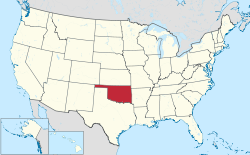| Lynching of Laura and L. D. Nelson | |
|---|---|
 Photograph no. 2899, one of four extant photographs of the lynching | |
| Date | May 25, 1911 |
| Photographer | George Henry Farnum |
| Location | Six miles west and one mile south of Okemah, Oklahoma, on a bridge, now demolished, across the North Canadian River. [1] (The replacement bridge became part of Oklahoma State Highway 56.) |
| Coordinates | 35°25′46″N96°24′28″W / 35.42944°N 96.40778°W |
| Charges | None |
| Part of a series on |
| Nadir of American race relations |
|---|
 |
Laura and L. D. Nelson were an African-American mother and son who were lynched on May 25, 1911, near Okemah, Okfuskee County, Oklahoma. [1] [2] They had been seized from their cells in the Okemah county jail the night before by a group of up to 40 white men, reportedly including Charley Guthrie, father of the folk singer Woody Guthrie. [3] The Associated Press reported that Laura was raped. [a] She and L. D. were then hanged from a bridge over the North Canadian River. According to one source, Laura had a baby with her who survived the attack. [5]
Contents
- Background
- Lynching in the United States
- In Oklahoma
- People
- Nelson family
- George Loney
- Death of Loney
- Shooting
- Arrests and charges
- May 25, 1911
- Kidnap
- Lynching
- Photographs
- Aftermath
- Legacy
- Photographs 2
- Guthries
- See also
- Notes
- References
- Works cited
- Further reading
Laura and L. D. were in jail because L. D. had been accused of having shot and killed Deputy Sheriff George H. Loney of the Okfuskee County Sheriff's Office, [6] during a search of the Nelsons' farm for a stolen cow. L. D. and Laura were both charged with murder; Laura was charged because she allegedly grabbed the gun first. Her husband, Austin, pleaded guilty to larceny and was sent to the relative safety of the state prison in McAlester, while his wife and son were held in the county jail until their trial. [7] [8]
Sightseers gathered on the bridge on the morning of the lynching. George Henry Farnum, the owner of Okemah's only photography studio, took photographs, which were distributed as postcards, a common practice at the time. [9] Although the district judge convened a grand jury, the killers were never identified. [10] Four of Farnum's photographs are known to have survived—two spectator scenes and one close-up view each of L. D. and Laura. Three of the images were published in 2000 and exhibited at the Roth Horowitz Gallery in New York by James Allen, an antique collector. [11] The images of Laura Nelson are the only known surviving photographs of a black female lynching victim. [12] [13]










